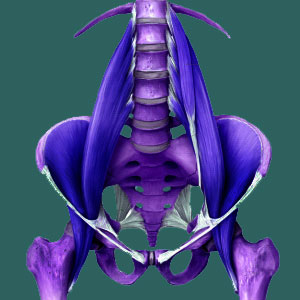
Sacroiliac exercises are primarily used for treating SIJ dysfunction caused by ligamentous concerns. Exercises and stretches can treat both hypomobility and hypermobility conditions in the SI joint. Exercises are also commonly recommended for patients with various other SI-related diagnoses, but for different reasons which will be explained in the course of this essay.
Exercise therapy can consist of professionally-applied physical therapy, trainer-supervised fitness routines or self-guided activities. There is no evidence that any of these paths is more successful than the others, but we do strongly suggest consulting with a physical therapist in order to learn the best forms of exercise for the SI joint before beginning any self-guided program of fitness activity.
This resource section describes the benefits of exercise and stretches for sacroiliac pain problems. We will explain the benefits and limitations of exercise therapy and provide insightful information that every patient should know about physical therapy.
Indications for Sacroiliac Exercises
Exercises are the primary treatment modality for all forms of sacroiliac joint dysfunction related to muscular and ligament issues. These conditions include hypermobility of the joint (also commonly diagnosed as sacroiliac joint instability), hypomobility of the joint (also diagnosed as SI fixation, SI rigidity) and muscular imbalances that negatively affect the SI joint.
Exercises are commonly also utilized for arthritic forms of sacroiliac conditions, as well as for postoperative rehabilitation of the joint in patients who have elected surgical fixes for their pain.
The biggest enigma involves the many cases where pain obviously exists in the sacroiliac region and exercises are prescribed without the patient even having the benefit of any diagnosed explanation for the symptoms. In fact, these idiopathic syndromes are most often treated with a combination of dangerous drugs and exercise recommendations, despite doctors not having any idea of the origin or mechanism of pain.
Discussions on SIJ Exercises
We have prepared a series of focused dialogs, each examining a specific aspect of exercise therapy for sacroiliac joint pain. As each discussion is published, it will be added to the list below:
Sacroiliac stretches work in tandem with exercises to accomplish various objectives, including strengthening, increasing flexibility or limiting movement in the joint.
Yoga for sacroiliac pain is a great activity-related form of exercise that is well-known to provide substantial benefits for some patients and some diagnoses.
Swimming for sacroiliac pain is a nonimpact, highly beneficial and safe form of rigorous fitness that can be enjoyed by patients at any age.
Sacroiliac Exercises Benefits and Limitations
For soft tissue-related diagnoses that involve atypical rigidity or instability in the joint, exercises might be very useful in correcting the problem without drugs or surgery. Many cases of SIJ dysfunction can be successfully treated using exercises and stretches that directly address hypo and hypermobility concerns.
Muscular imbalances infrequently affect the sacroiliac joint, as well, creating tension or laxity due to antagonistic pairings pulling on the joint or failing to provide proper support. Exercises are certainly the best way to address muscular deficiencies and imbalances, although it must be noted that a large percentage of all muscular imbalance diagnoses are incorrect.
For postsurgical rehabilitation of the SI joint following a fusion or other procedure, exercises can help to strengthen the tissues and improve healing response by increasing circulation and metabolism in the region.
Exercises are not indicated by most forms of sacroiliitis and will usually do nothing to address joint deterioration. Since the SI joint has very limited mobility, exercise will not be able to wear away accumulated arthritic spurs and material in the joint as it might accomplish in the spinal segments or other large mobile joints.
Exercise is often used by doctors in an attempt to “do something constructive” even when the indication for physical therapy is not truly met. Enlightened doctors prefer to prescribe exercise, since it is good for the body and without risk, unlike basically all other SI joint pain treatments, such as pharmacological therapy, injection therapy or surgical intervention. However, this does not make exercise particularly effective for treating many forms of SI joint pain, especially those cases that are considered idiopathic in origin.
It should be noted that exercise will likely provide temporary relief from ischemia syndromes in the SI joint, but will stand virtually no hope of providing a cure, since most of these conditions are motivated by psychoemotional issues and not any structural defect or deficiency. The better path of treatment would be a course of knowledge therapy to address the underlying causative issues and exercise afterwards to improve general strength in the region after suffering under the cruel torment of oxygen deprivation for so long.
I detail my own personal exercise plan in my helpful book Back Exercises and Stretches. It is available as part of our comprehensive pain relief program on our product page.
Sacroiliac Joint Pain > Sacroiliac Exercises





